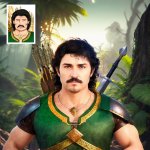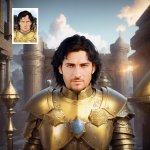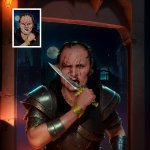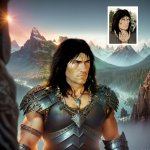-
 The VOIDRUNNER'S CODEX is coming! Explore new worlds, fight oppressive empires, fend off fearsome aliens, and wield deadly psionics with this comprehensive boxed set expansion for 5E and A5E!
The VOIDRUNNER'S CODEX is coming! Explore new worlds, fight oppressive empires, fend off fearsome aliens, and wield deadly psionics with this comprehensive boxed set expansion for 5E and A5E!
You are using an out of date browser. It may not display this or other websites correctly.
You should upgrade or use an alternative browser.
You should upgrade or use an alternative browser.
D&D General Using AI for character visualization
- Thread starter Myrhdraak
- Start date
Oligopsony
Explorer
Things I’ve found helpful/fun:
1) I’m too much of a cheapskate to shell out for a gaming PC or a subscription, so I usually rely on mage.space or Playground AI, which offer basically unlimited SDXL runs.
2) You can interleave the names of famous people to create consistent-looking characters: “Abraham Frederick Lincoln Douglass,” or whatever. This is also useful for variance when you use artists that tend to produce the same face over and over again, like Lucian Freud.
3) I’ll often do txt2img for composition and then img2img for finishing. Comics artists like Jack Kirby, Moebius, and Hal Foster are great for dynamic poses and imaginative scenes (composition), while classical portraitists like Delacroix, John Singer Sergeant, Ilya Repin, Egon Schiele, and Lucian Freud are my go-to finishers for the way they capture really subtle emotions in their subjects. Don’t be afraid to be a bit perverse with artist tokens; “colorful illustration by Albrecht Durer” often produces this really wonderful style reminiscent (to me) of Tony DiTerlizzi, for instance.
4) One thing you will find yourself finickily managing if you want distinctive, realistic subjects is a sort of general “beauty” axis; too far to the left and you can get a lot of unrealistic deformities that you didn’t intend and don’t make sense, too far to the right and everything comes out as superficially appealing but boring and interchangeable. (These can overlap.) How you use negative prompts, whether you include the long tacky boilerplate prompts, weights, refiner %, and much else will affect this. To go with my finishing artists above, Delacroix and especially Sergeant have a tendency to idealize their subjects, while Schiele and Freud have the opposite tendency, so which I use will depend on how I need to nudge that particular axis.
5) The model will almost always go with the most stereotypical interpretation it can get away with - everything from demographic biases to “wizard have beards and pointy hats OR are Harry Potter” and so on. For anything interesting, sculpt away the things ehyou don’t want, play around with vocab, and so on. This is an area where experimenting can really pay off. To get nonwhite/nonwestern subjects there’s a variety of tricks to learn, “from [place],” celebrities as noted above, artist choice, directly stated cultural influence. Getting deliberate about a particular mix of cultural influences is great for concerting/worldbuilding, pick two cultures that have a lot in common but didn’t interact much historically and see what you get, I had a lot of fun with Incan/Byzantine for my current project’s big empire for instance.
6) It’s so easy to run generations, so don’t settle for the first thing it outputs; instead make ten things, select the best, then make ten variations of that, and so on. Let the tool play to its strengths (brute force) and you to yours (evaluation and intent.)
This is a young medium where basically anyone can discover or explore a style for the first time, and the tools are evolving pretty rapidly, I think it’s a fun place to be, and I’m hoping that the tentative noncopyrightable status holds so it remains a noncommercial/nonprofessional space, like GMing or fanfiction - I think the culture at large needs more of those.
1) I’m too much of a cheapskate to shell out for a gaming PC or a subscription, so I usually rely on mage.space or Playground AI, which offer basically unlimited SDXL runs.
2) You can interleave the names of famous people to create consistent-looking characters: “Abraham Frederick Lincoln Douglass,” or whatever. This is also useful for variance when you use artists that tend to produce the same face over and over again, like Lucian Freud.
3) I’ll often do txt2img for composition and then img2img for finishing. Comics artists like Jack Kirby, Moebius, and Hal Foster are great for dynamic poses and imaginative scenes (composition), while classical portraitists like Delacroix, John Singer Sergeant, Ilya Repin, Egon Schiele, and Lucian Freud are my go-to finishers for the way they capture really subtle emotions in their subjects. Don’t be afraid to be a bit perverse with artist tokens; “colorful illustration by Albrecht Durer” often produces this really wonderful style reminiscent (to me) of Tony DiTerlizzi, for instance.
4) One thing you will find yourself finickily managing if you want distinctive, realistic subjects is a sort of general “beauty” axis; too far to the left and you can get a lot of unrealistic deformities that you didn’t intend and don’t make sense, too far to the right and everything comes out as superficially appealing but boring and interchangeable. (These can overlap.) How you use negative prompts, whether you include the long tacky boilerplate prompts, weights, refiner %, and much else will affect this. To go with my finishing artists above, Delacroix and especially Sergeant have a tendency to idealize their subjects, while Schiele and Freud have the opposite tendency, so which I use will depend on how I need to nudge that particular axis.
5) The model will almost always go with the most stereotypical interpretation it can get away with - everything from demographic biases to “wizard have beards and pointy hats OR are Harry Potter” and so on. For anything interesting, sculpt away the things ehyou don’t want, play around with vocab, and so on. This is an area where experimenting can really pay off. To get nonwhite/nonwestern subjects there’s a variety of tricks to learn, “from [place],” celebrities as noted above, artist choice, directly stated cultural influence. Getting deliberate about a particular mix of cultural influences is great for concerting/worldbuilding, pick two cultures that have a lot in common but didn’t interact much historically and see what you get, I had a lot of fun with Incan/Byzantine for my current project’s big empire for instance.
6) It’s so easy to run generations, so don’t settle for the first thing it outputs; instead make ten things, select the best, then make ten variations of that, and so on. Let the tool play to its strengths (brute force) and you to yours (evaluation and intent.)
This is a young medium where basically anyone can discover or explore a style for the first time, and the tools are evolving pretty rapidly, I think it’s a fun place to be, and I’m hoping that the tentative noncopyrightable status holds so it remains a noncommercial/nonprofessional space, like GMing or fanfiction - I think the culture at large needs more of those.
LuisCarlos17f
Legend
It is perfect to create portraits, but not scenes in more dinamic poses. Even a simple couple kissing may be hard. And forget the idea of a group of heroes fighting against a dragon or a boss monster. You can't be too happy with those creations.
Horwath
Legend
What did you input for that image?Today I made the party Ranger.
/Myrhdraak
That 70's porn actor?

Myrhdraak
Explorer
Yes, Ron's name has been mentioned several times during game play. In all fairness the character had quite low "Comeliness", or whatever they called it in 2nd Edition (was it Unearthed Arcana or a Dragon magazine that introduced it?)What did you input for that image?
That 70's porn actor?
I’ve worked in pencil, ink, pastels, acrylic paints and other media for decades.
I tried some of the earlier AIs, and- while I liked some of the images generated- none of them particularly worked as character images. So I stopped fiddling with them.
They’ve clearly improved a great deal, but I’m not sure I’ll ever go back to them.
I tried some of the earlier AIs, and- while I liked some of the images generated- none of them particularly worked as character images. So I stopped fiddling with them.
They’ve clearly improved a great deal, but I’m not sure I’ll ever go back to them.
Similar Threads
- Replies
- 7
- Views
- 502
- Replies
- 43
- Views
- 3K
- Replies
- 258
- Views
- 17K
- Replies
- 140
- Views
- 19K
- Replies
- 210
- Views
- 21K




